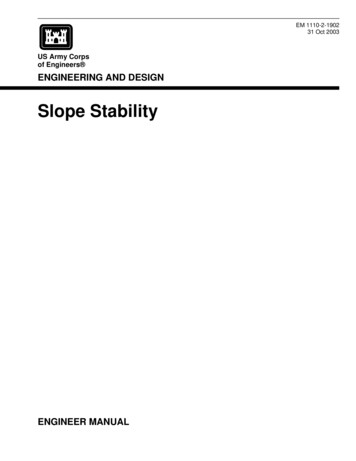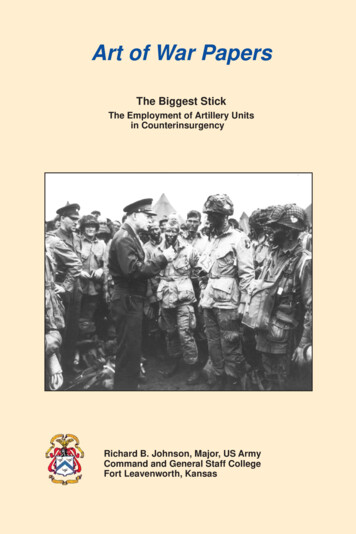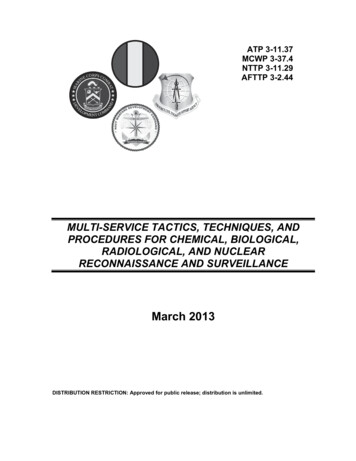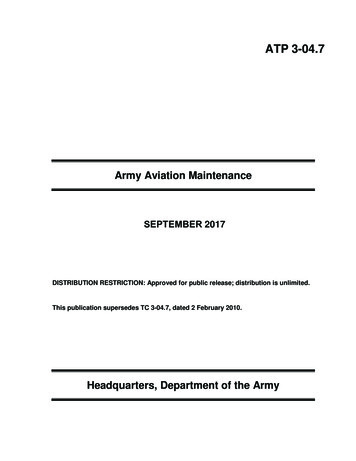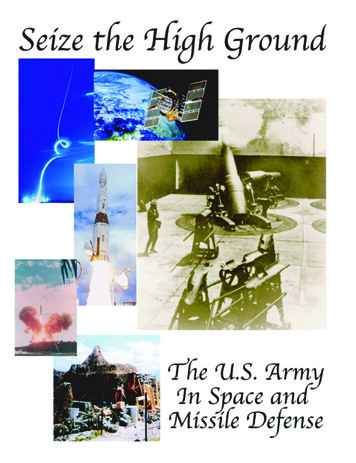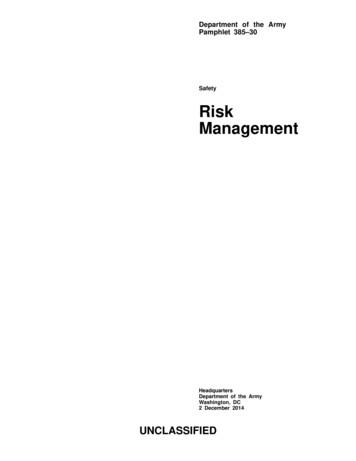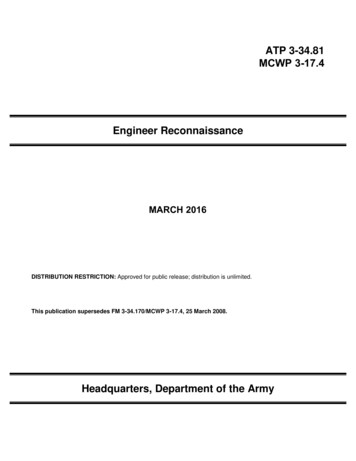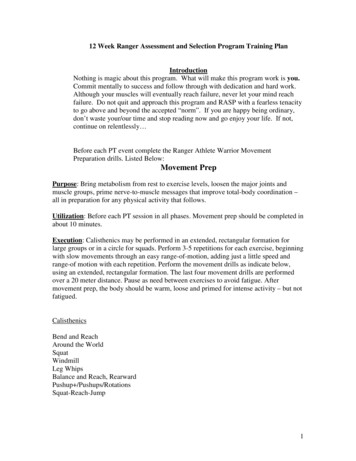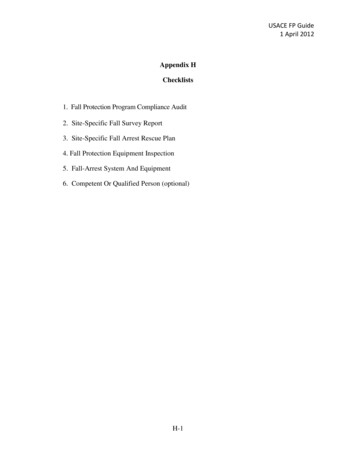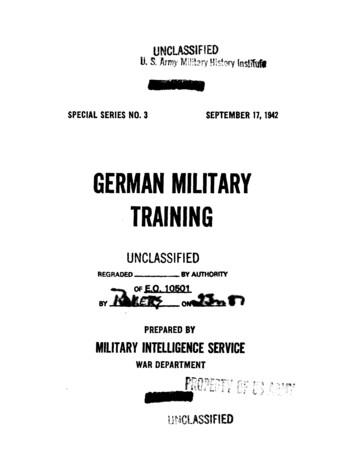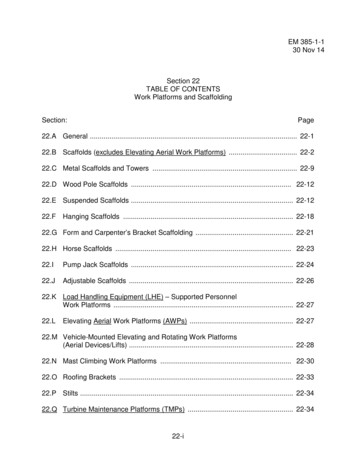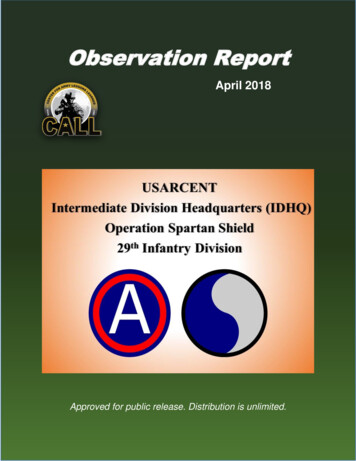
Transcription
Observation ReportApril 2018Approved for public release. Distribution is unlimited.
29th Infantry Division Intermediate Division Headquarters Observation ReportExecutive SummaryIn the late summer of 2016, the 29th Infantry Division received notice that it was to become theU.S. Army Central's (ARCENT) intermediate division headquarters (IDHQ) for OperationSpartan Shield (OSS). OSS is a combined forces contingency operation designed to deter andreact to possible threats within the U.S. Central Command (CENTCOM) Area of Responsibility(AOR). The IDHQ would assume the mission command of all forces in OSS. Task ForceSpartan (TF Spartan) consisted of more than 12,000 soldiers in an Armored Brigade CombatTeam (ABCT), Fires Brigade, Engineer Brigade, Air Defense Brigade, and Combat AviationBrigade. In addition, ARCENT decided to source the core staff element of the Combined JointOperations Command-Jordan of around 80 personnel from the same division headquarters as theIDHQ since the 29th Infantry Division had already received that mission a few months earlier.The CJOC-J element arrived in Jordan in September, while the balance of the divisionheadquarters arrived in Kuwait in December and immediately assumed the duty as the IDHQ.The IDHQ’s primary task was to execute mission command for Task Force Spartan’s steadystate operations of providing deterrence through presence, theater security cooperation, andmissile defense in the CENTCOM AOR, in addition to providing extensive aviation, fires, andengineer support to other operational commands in the AOR. This was the steady state part ofthe IDHQ as described in the ARCENT OPORD. The IDHQ’s secondary mission was to planand execute contingency operations throughout the ARCENT area of operations; this was the“fight tonight” part of the mission.Although the 29th Infantry Division had deployed headquarters elements to the Balkans andAfghanistan four times in the preceding 15 years, the Spartan Shield mission marked the firsttime the Division exercised mission command of subordinate brigades in a deployedenvironment since World War II. As such, the 29th needed to refresh many of the skills neededto function as a full division headquarters. Once the Division assumed operations in Kuwait, thestaff was able to gain experience and the headquarters’ effectiveness saw consistentimprovement throughout the deployment.The integration of the new headquarters in the CENTCOM area came with some growing pains,but was ultimately successful. The introduction of a 2-star headquarters was the right fit, as thenormal mission command higher headquarters for a brigade is a division. The IDHQ, ARCENTForward and ARCENT Main worked cooperatively during the first few months to establishappropriate lines of authority and responsibilities for the steady state.Overall, the intermediate division headquarters proved that it is value added to the continuationof the OSS mission while freeing staff manpower of ARCENT for theater army tasks.The purpose of this report is to describe observations made during the 29th ID's deployment tothe ARCENT AOR to serve as the IDHQ from the period December 2017 to July 2018. Thereport will also highlight lessons and best practices used during this mission that can assistfollow-on IDHQs in preparing for their deployment, and rapidly integrating into the ARCENTmission command structure once in theater.Unclassified2
29th Infantry Division Intermediate Division Headquarters Observation Report29th Infantry Division Key Leaders Interviewed:Commanding GeneralDeputy Commanding General - OperationsDivision Chief of StaffDivision Command Sergeant MajorDeputy Chief of StaffDivision G1Division G2Division Deputy G3Division G7/9Division G8Fires ChiefDivision EngineerJudge Advocate GeneralInspector GeneralProtection ChiefPublic Affairs OfficerADA LNO to 29 IDKey observations: The standard DATE Warfighting scenario did not prepare the headquarters staff for thesteady state operations nature of the IDHQ’s primary role in OSS. Neither the Division staff nor their First Army trainers had a clear understanding of themission or of the tasks required of the IDHQ. The term “steady state” that ARCENToften used initially conveyed little information to help the staffs determine what theIDHQ would do. The 90-day deployment timeline and the last-minute addition of personnel detracted fromthe ability to build cohesive and effective staff sections. The DATE scenario as theculminating training exercise did not provide the opportunity for team building of themany just recently formed staff sections. For some sections, technical lines of authority and division of responsibility betweenorganizations remained unclear for the first several months of the deployment. The division had difficulty filling many low-density high demand functional staffpositions, specifically civil affairs operations, psychological operations, safety, spaceoperations, and public affairs. Due to the heavy theater engagement mission, every leader in TF Spartan from companycommander and up will conduct engagements with the military forces in the region.Forces supporting OSS operate in many different countries and cultures surrounding theArabian Gulf region. Study and education before and during the deployment are requiredto be successful.Unclassified3
29th Infantry Division Intermediate Division Headquarters Observation ReportTable of ContentsIDHQ Concept1-11-2Army division in the IDHQ conceptIDHQ performing both TF Spartan and CJOC-J missionsPre-deployment Readiness and Training2-12-22-32-4IDHQ Roles and FunctionsFilling Functional Area StaffThe MOB ProcessIDHQ Culminating Training Exercise (CTE)Staff Functions3-13-23-33-43-53-63-73-83-9Sustaining Training Readiness of the OSS units29ID Staff Judge AdvocateSJA Division of LaborIntegrating the Engineer HeadquartersNon-Standard Alignment of Air Defense Artillery BrigadeIDHQ Fires CellPublic Affairs in the IDHQIDHQ Division ConstructSentinel RadarBuilding Partner Capacity4-14-24-3Leader education: Operational EnvironmentBuilding Partnership CapacityExchange Information with Coalition PartnersUnclassified4
29th Infantry Division Intermediate Division Headquarters Observation ReportIDHQ Concept1-1. Observation: Yes, the IDHQ concept does work and is sustainable.Discussion: The IDHQ concept is the right answer to providing mission command for multiplebrigades deployed to the theater. The design and staffing of a division headquarters allows it tocontrol multiple brigades. Divisions functionally command brigades during all phases of forcegeneration (i.e., training readiness) through operational mission command on the battlefield. Thedesign and organization of an Army Service Component Command (ASCC) does not readilylend itself to direct interaction with a brigade headquarters. The ASCC is a theater level assetmeant to support the COCOM and to set the conditions for ARFOR entry into the theater. Theyare not organized and staffed to command brigade(s) for a sustained period.Lesson: The division is the best headquarters echelon for command of the brigades in theARCENT/CENTCOM area. With eight National Guard divisions available as a force pool tocontinue to source the IDHQ, it appears that the mission could continue indefinitely, as two willbe available to deploy each year. These deployments also improve the mission commandcapabilities and proficiencies of the National Guard divisions.1-2. Observation: The IDHQ can perform both TF Spartan and CJOC-J missions satisfactorilywith a division MTOE.Discussion: 29th Infantry Division mobilized its CJOC-J element before the rest of the divisionreceived a mobilization order to assume duties as the IDHQ. As a result, the 29th ID filled theCJOC-J with several of the Division’s primary staff officers and senior NCOs in addition to theDeputy Commanding General for Support. The initial CJOC-J design for the first NationalGuard rotation could largely be termed a Division Tactical CP without its logistics support, asARCENT contemplated providing the 29th ID HQ (-) BOS-I, signal, MI, and other enablers fromother theater assets.As the CJOC-J mission grew less operational than the prior incarnation headed by 1AD (-) andbecame more focused on BOS-I, setting the theater, and theater security cooperation tasks,ARCENT and other service-provided enablers began to disappear. CJOC-J requested that thedivision backfill several BOS-I and intelligence tasks, in particular, and ultimately the Divisionfootprint in Jordan expanded from 82 soldiers to over 100.Despite a minimal operational role, however, CJOC-J continued to represent a significantdiversion of resources from the TF Spartan mission, including dozens of officers from thedivision coordinating staff sections. The G3 paid an especially steep personnel price to maintaina parallel round-the-clock operations center at CJOC-J. Due to inertia and other factors, CJOC-Jcontinued to function as a separate, non-complementary headquarters even after the Divisionestablished TF Spartan in Kuwait.As the Division submitted in its assessment to ARCENT, the CJOC-J mission relates to the TFSpartan mission and efficiencies are possible if later IDHQs approach the two mission sets as aunitary headquarters rather than two completely separate organizations. The lowest risk to theUnclassified5
29th Infantry Division Intermediate Division Headquarters Observation ReportTF Spartan “fight tonight” mission, however, would be for a Regional Support Group or otherBOS-I, theater-setting-focused organization assume responsibility as ARFOR-J and reduce theDivision’s mission to a handful of officers working with the Amman Embassy MILTEAM onarranging theater security cooperation events with TF Spartan units.Lesson: Performing both missions, IDHQ steady state and the CJOC-J, with a standard Armydivision headquarters is feasible. In the case of the 29th ID, the CJOC-J staffing design includedexcess operations-focused personnel. Reallocating these personnel to the IDHQ main commandpost to reduce risk to the unified action mission was a better option than keeping them in Jordan.However, this did not happen.PREDEPLOYMENT READINESS AND TRAINING2-1. Observation: Initally the division struggled to determine what roles and functions ARCENTassigned to the IDHQ.Discussion: The start point was the ARCENT EXORD order defining the IDHQ. The EXORDdefined the IDHQ as the senior tactical headquarters in OSS, bridging the operational strategictheater army and the OSS tactical brigade headquarters. The ARCENT Forward Command Post,also located in theater, had a very limited capacity to be a mission command element.ARCENT developed a transition checklist of specific tasks broken down by staff section that the29th would assume. Two issues became immediately apparent. ARCENT, being an ASCC had adifferent level of thought between the operational and strategic than did the divisionheadquarters. There were some discrepancies between what ARCENT thought a division oughtto do, or is able to do, and what a division is structured and trained to do.Adding confusion was that the ARCENT and Division staffs divided responsibilities differently,owing to their differing constructs. ARCENT employs far more sectional divisions, e.g., a G-31,G-32, G-33, etc., than a division, so it was sometimes unclear to the Division whereresponsibility for individual issues lay within the technical channels. Ultimately, withexperience, both sides learned how to integrate across their respective structures.Lesson: The IDHQ must continue to assess how to integrate and align staffs with the ARCENTStaff construct. The IDHQ and ARCENT conducted a 90-day assessment and risk to missionanalysis which generated inputs to a revised ARCENT EXORD issued to the follow-on IDHQdivision.2-2. Observation: National Guard divisions have difficulty in filling functional area staffpositions.Discussion: As part of their mobilization and preparation, the division headquarters identifiedseveral functional area staff positions that were unfilled. These low density specialties includedpublic affairs, civil affairs, space operations, simulations operations, and knowledgeUnclassified6
29th Infantry Division Intermediate Division Headquarters Observation Reportmanagement. To rectify the shortfalls the division either (1) sent officers to school whom thendeployed late, or (2) requested that National Guard Bureau find “fills” from another state, or (3)requested fills from the Army Reserve.Within National Guard divisions, these positions are hard to fill. In the case of space operationsand civil affairs, these positions exist in the National Guard (as opposed to the USAR) only at theDivision or Theater asset level—and then at the field grade or senior NCO rank level—so thereis no natural pipeline within the state to develop experience in the field. Money is anotherproblem, since sending officers and senior NCOs to retrain in these specialties is expensive andrequires six to as many as 30 weeks active duty for the officer(s) attending, depending on thespecialty. States are frequently reluctant to fund these courses, often assessing that they can funddozens of Soldiers for career-required schools like Warrior Leader Course for the cost of sendingone officer to a lengthy school for which there is no guarantee that he/she will remain in theposition requiring it for long. The funding problem is even further complicated when theNational Guard division headquarters is divided between two or more states.The second problem is finding officers who are both qualified to attend and can afford the timeaway from their civilian careers. These functional area courses typically are at least six weeks induration, and for many Guard members taking the time off from their civilian job is not practical.While it depends heavily on a state’s force structure, in most cases few National Guard officerscan successfully remain in a single basic branch ov
Observation Report April 2018 Approved for public release. Distribution is unlimited. 29th Infantry Division Intermediate Division Headquarters Observation Report Unclassified 2 Executive Summary In the late summer of 2016, the 29th Infantry Division received notice that it was to become the U.S. Army Central's (ARCENT) intermediate division headquarters (IDHQ) for Operation Spartan Shield .
